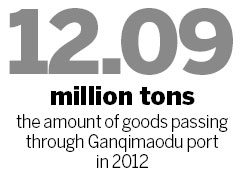Border outpost turned into mining boomtown
In less than 20 years, Ganqimaodu has become a key entry point for tons of coal destined for China, report Wang Kaihao in Urad Middle Banner, Inner Mongolia, and Zhu Zhe in Ulan Bator
Many of the buildings under construction in Ganqimaodu, a town deep in the Gobi Desert on the China-Mongolia border, have been designed in Russian and Mongolian styles.
This town was little more than barren land 20 years ago, but it has become a hub for trucks shuttling across the border, and is considered one of the largest border crossings between Mongolia and North China's Inner Mongolia autonomous region.
|
 |
Though the temperatures often fall below -20 C in winter, local stores are doing brisk business.
"We want to make Chinese people feel right at home, even though they might be far from home," said Yuan Yuefeng, the chief of Ganqimaodu Port Authority
According to Yuan, 12.09 million tons of goods passed through Ganqimaodu in 2012, a 13 percent rise on 2011, making it the country's second-biggest road port in terms of transit shipments after Shenzhen.
All except 300,000 tons of that was coal from Mongolia, making this busy town China's largest gateway for importing coal from the country.
There are 15 coalfields in Mongolia, with total reserves estimated at 162.4 billion tons. Of the country's 26 coal producers, 13 are exporters, according to JYD Online Co Ltd, a Beijing-based commodity consultancy.
The first Chinese bank office in Mongolia, the Ulan Bator branch of the Bank of China, was opened on Thursday, becoming only the third foreign bank outlet to open in that country, according to Naidansuren Zoljargal, the governor of the Central Bank of Mongolia.
During the opening ceremony, he said China is Mongolia's biggest trading partner and top investment source.
The establishment of the BOC's Ulan Bator branch will boost investment and financial cooperation between the two countries, he added.
Bank of China President Li Lihui said the bank valued the Mongolian market greatly, and pledged to provide quality financial service for enterprises from the both countries.
Since September 2010, all of Mongolia's coal exports have been going to China.
Although China itself is rich in coal reserves, they are mainly thermal coal used for coal-fired power generation, explained Dai Bing, director of the coal industry information department at JYD.
"China lacks coking coal for its steel production," he said.
"The government is encouraging importing coal from other countries including Australia and Indonesia."
China imported 290 million metric tons of coal in 2012, a 29.8 percent rise year-on-year, according to Customs figures.
The crossing at Ganqimaodu was established in 1992 but only opened fully in 2009, when it was upgraded as a national-level border point run all-year-around.
Its total transit shipments during its first 18 years were just 10.6 million tons.
Cogt is an officer from the frontier inspection station who has worked in Ganqimaodu for 10 years.
"Only between 10,000 and 20,000 tons of goods passed here per year at the very start," he said.
"People then mostly traded wool, clothes, irons and general household articles."
But the huge coal deposits near the border have changed its fortunes.
Tavan Tolgoi coal mine, one of the world's largest untapped coal deposits, lies just 190 km from Ganqimaodu.
Cogt said that a truck takes just one minute at the border control after the new system was introduced, and on average 1,000 trucks now pass through every day.
- China, Mongolia to expand cooperation
- Chalco threatens legal action in Mongolia deal
- Mongolia's Erdenes TT halts coal exports to China
- China's rare earths giant continues production halt
- China, Mongolia sign agricultural co-op deal
- China encourages mining co-op with Mongolia
- System to price rare earths
- Chinalco extends bid for Mongolian coal miner























